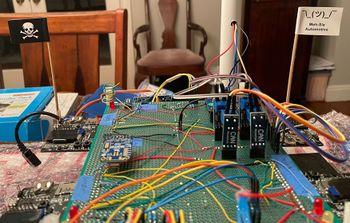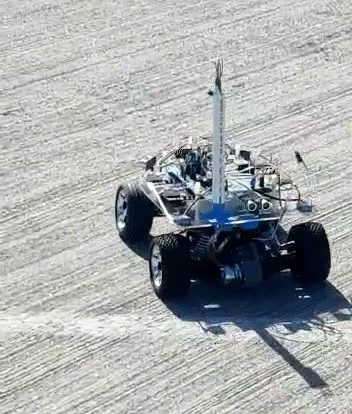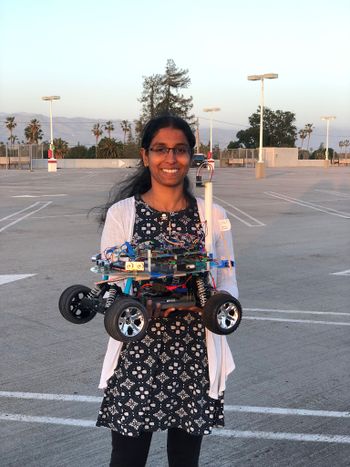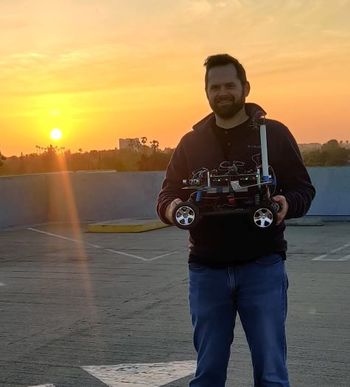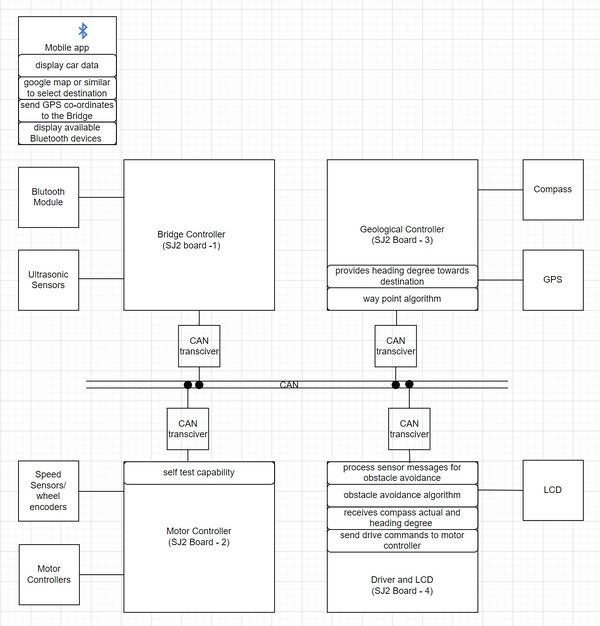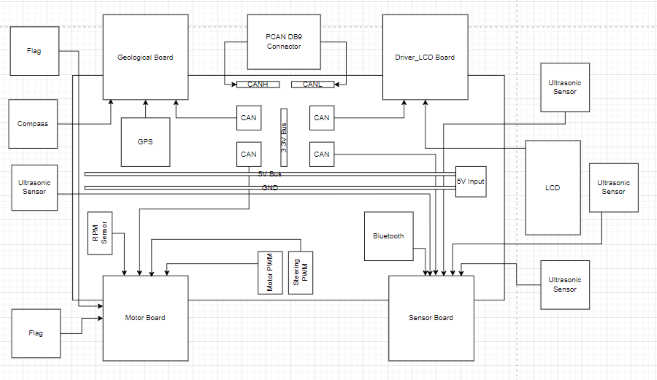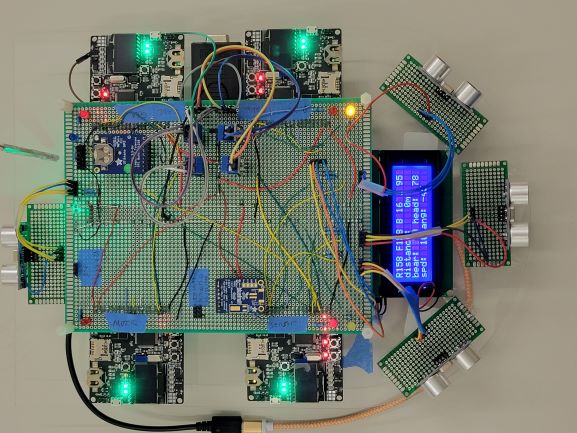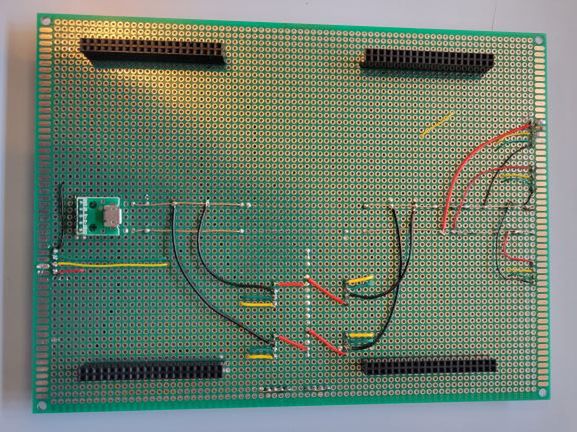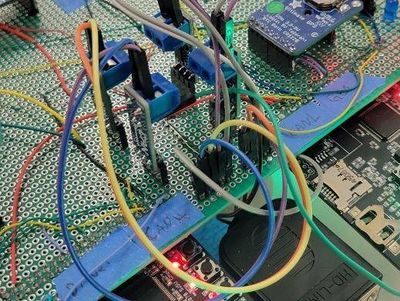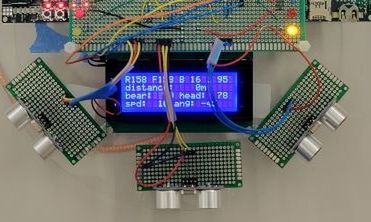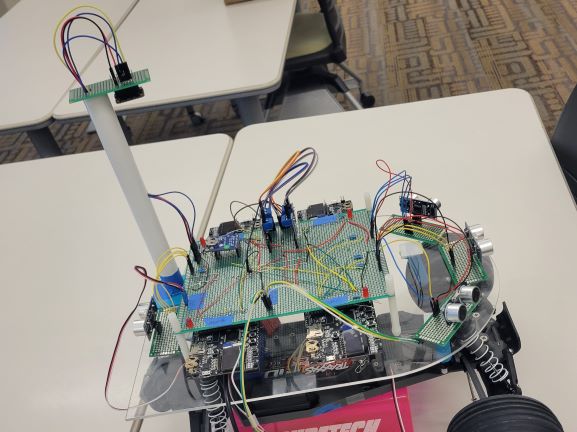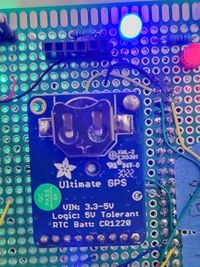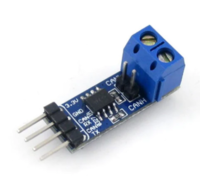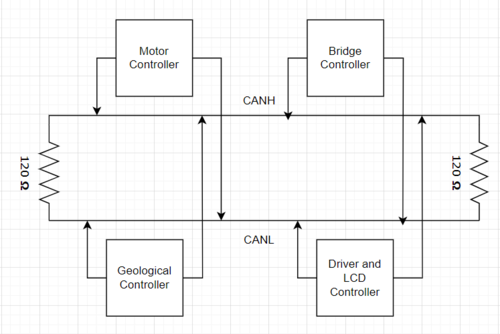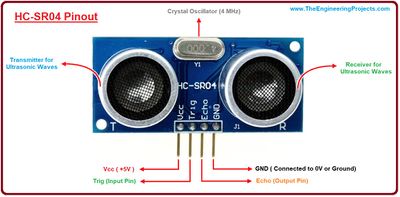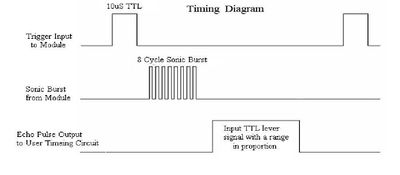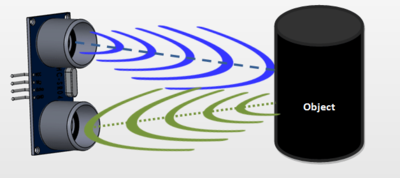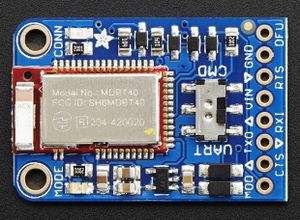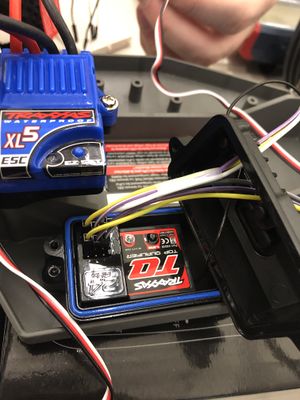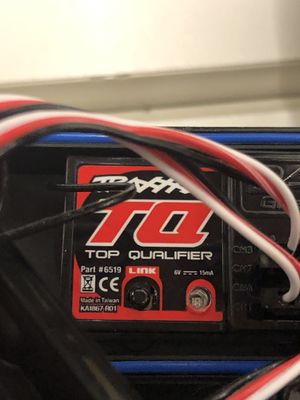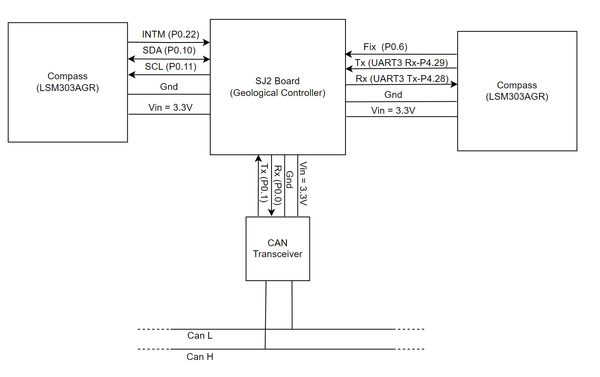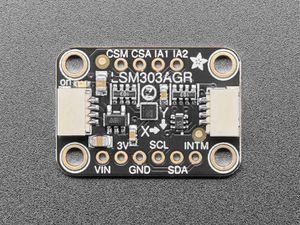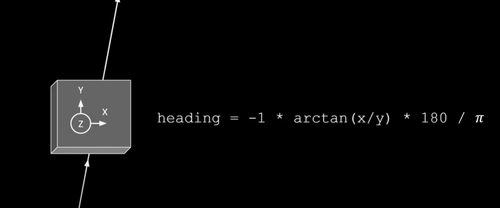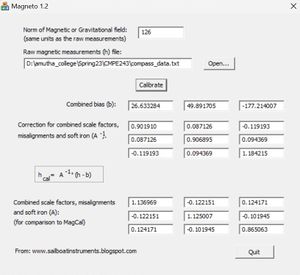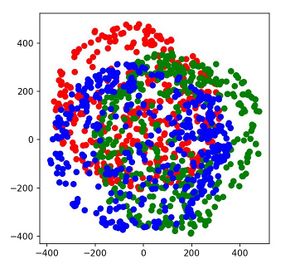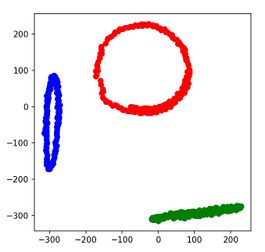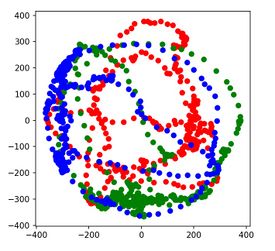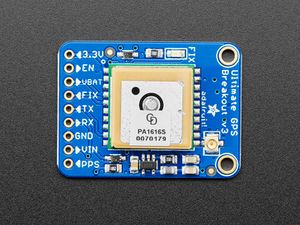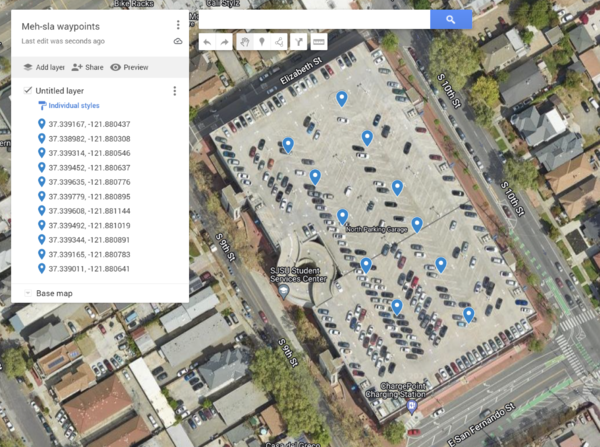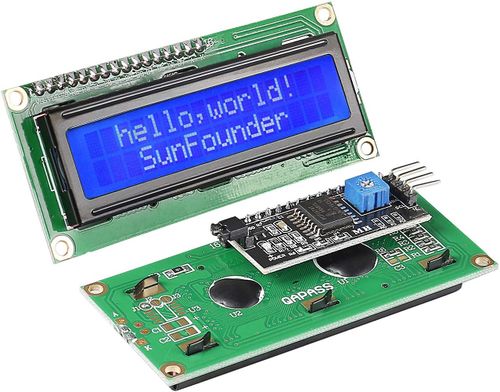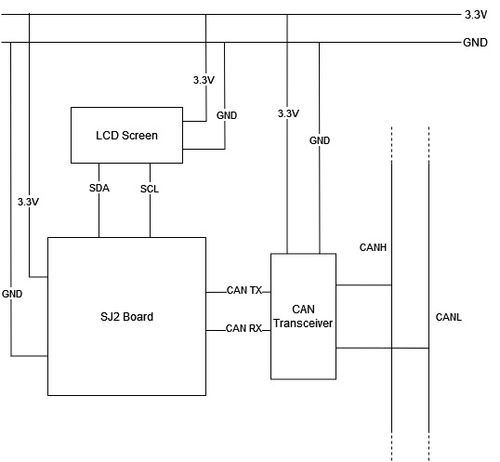S23: Meh-sla Automotive
Contents
Project Title
¯\_(ツ)_/¯ Meh-Sla Automotive ¯\_(ツ)_/¯
Abstract
The ultimate goal of the project is to design an autonomous car that navigates from its current location to a destination. Along its way, it needs to avoid obstacles and follow the waypoints. To achieve this we are using four SJ2 boards that communicate with each other via CAN bus along with the required sensors and a mobile app that communicates with one of the SJ2 boards via Bluetooth. Through our experience, we knew that we wouldn't be the Worst-Sla. We say that we are Meh-Sla even though we know we are the Best-Sla.
Introduction
The project was divided into 5 modules:
1) Sensor and bridge controller:
- Interfaced with 4 ultrasonic sensors for obstacle detection.
- Interfaced with a Bluetooth module for the controller to mobile app communication.
2) Motor controller:
- Interfaced with vehicle motor to control its speed and steering.
- Interfaced with RPM sensors to get feedback about the vehicle's speed.
3) Geographical controller:
- Interfaced with a magnetometer to get the current heading of the vehicle.
- Interfaced with a GPS module to get the current location information.
4) Driver and LCD controller:
- Process information from the sensor and geological board, and send speed and steering to the motor board based on obstacle avoidance and path determination algorithm.
- Interfaced with an LCD module to display the vehicle status.
5) Mobile App:
- Communicates over Bluetooth.
- Sends destination location or start/stop signal to the car.
- Receives sensor and other navigation status and displays it.
Team Members & Responsibilities
- Team Lead
- Motor Board
- Geo Board
- Android App
- Driver and LCD Board
- Sensor Board
- Geo Board
- Hardware Design
- Software Testing
Schedule
| Week # | Start Date | End Date | Task | Status |
|---|---|---|---|---|
| 1 | 2/12/2023 | 2/18/2023 |
|
|
| 2 | 2/19/2023 | 2/25/2023 |
|
|
| 3 | 26/2/2023 | 3/4/2023 |
|
|
| 4 | 3/5/2023 | 3/11/2023 |
|
|
| 5 | 3/12/2023 | 3/18/2023 |
|
|
| 6 | 3/19/2023 | 3/25/2023 |
|
|
| 7 | 3/26/2023 | 4/1/2023 |
|
|
| 8 | 4/2/2023 | 4/8/2023 |
|
|
| 9 | 4/9/2023 | 4/15/2023 |
|
|
| 10 | 4/16/2023 | 4/22/2023 |
|
|
| 11 | 4/23/2023 | 4/29/2023 |
|
|
| 12 | 4/30/2023 | 5/6/2023 |
|
|
| 13 | 5/7/2023 | 5/13/2023 |
|
|
| 14 | 5/14/2023 | 5/19/2023 |
|
|
| 15 | 5/20/2023 | 5/26/2023 |
|
|
Parts List & Cost
| Item# | Part Description | Vendor | Qty | Cost |
|---|---|---|---|---|
| 1 | RC Car | Traxxas | 1 | $250.00 |
| 2 | SJ2 board | From Preet [1] | 4 | $50.00 |
| 3 | CAN Transceivers (SN65HVD230) | Waveshare [2] | 4 | Free Samples |
| 4 | RC Car RPM | Traxxas [3] | 1 | $8.23 |
| 5 | Adafruit Bluetooth BLE Friend | Adafruit [4] | 1 | $17.5 |
| 6 | GPS Module | Adafruit [5] | 1 | $29.95 |
| 7 | Compass Module | Adafruit [6] | 1 | $12.50 |
| 8 | Ultrasonic Sensors | Adafruit [7] | 4 | $3.95 |
| 9 | LCD Screen | Amazon [8] | 1 | $12.89 |
System Hardware Design
Block Diagram
Layout Diagram
Layout Description
The system implemented four SJTwo boards, positioned with their tops facing upwards and protruding from beneath the PCB. This arrangement allowed for convenient utilization of the onboard LEDs and easy access to the Reset buttons on each board. Although this design choice sacrificed compactness, it provided early access to the LEDs during development. Furthermore, this configuration facilitated the division of the PCB into four quadrants for the rest of the design.
To power the entire system, a portable 20,000mAh power bank was employed, connecting to the PCB via a micro USB connector. From the connector, a 5V and GND bus was integrated into the center of the PCB using a bus wire. This power distribution arrangement ensured consistent voltage supply to the four SJTwo boards and other peripherals. By delivering power through a unified 5V line, all voltage references remained relative to each other. Moreover, this design reduced clutter by offering multiple points for connecting 5V and GND, facilitated by the bus running the length of the PCB.
To optimize PCB space, the four CAN transceivers were positioned upright in a 2x2 formation between two SJTwo boards. This configuration allowed for the creation of nearby CANH and CANL buses, ensuring easy accessibility for the PCAN dongle. The CAN transceivers were powered by a 3.3V bus created by connecting all the 3.3V SJTwo outputs, thus maintaining consistent voltage levels.
The four ultrasonic sensors were mounted on daughter boards, offering flexibility for precise directional adjustment without impacting the rest of the system. Three sensors were placed in the front of the car for the right, front, and left directions, while one sensor was positioned at the rear. The LCD screen was strategically placed behind the front sensors to prevent interference and any potential movement in case of dislodgment.
To minimize interference from other components, the compass was mounted on a pole. A lightweight PVC pipe was chosen to allow for wire routing inside it, resulting in a cleaner overall appearance.
The GPS and Bluetooth modules were positioned next to the respective controlling SJTwo board. The motor's battery, ESC, and RPM sensor were all mounted on the vehicle's chassis.
Each board featured a red LED to indicate CAN MIA (Missing in Action). The two front yellow LEDs served as obstacle avoidance indicators: when an object was detected on the right or left side, the corresponding LED would light up, and if an obstacle was detected in the front, both LEDs would illuminate. If neither LED was lit, the car would operate based on path determination rather than obstacle avoidance. The green LED under the PCB indicated power supply, while the blue LED at the back would blink during GPS pairing and remain steadily lit once the GPS successfully locked onto a signal.
CAN Communication
We selected our message IDs using a mutually agreed-upon priority scheme. Messages responsible for controlling the car were given high-priority IDs, while sensor and GEO messages were assigned the next level of priority. Debug and status messages received the lowest priority IDs.
Hardware Design
We opted for the Waveshare CAN transceiver in our design due to its exceptional reliability, integrated 120-ohm resistor(we removed them off two boards), vertical mounting capability, and dual CANH/L connectors. The four CAN transceivers were strategically positioned upright in a 2x2 arrangement between two SJTwo boards. This layout facilitated the creation of closely located 5-pin CANH and CANL buses, ensuring effortless access for the PCAN dongle. Powering the CAN transceivers was achieved through a 3.3V bus formed by connecting all the 3.3V SJTwo outputs, guaranteeing consistent voltage levels throughout the system.
DBC File
VERSION "" NS_ : BA_ BA_DEF_ BA_DEF_DEF_ BA_DEF_DEF_REL_ BA_DEF_REL_ BA_DEF_SGTYPE_ BA_REL_ BA_SGTYPE_ BO_TX_BU_ BU_BO_REL_ BU_EV_REL_ BU_SG_REL_ CAT_ CAT_DEF_ CM_ ENVVAR_DATA_ EV_DATA_ FILTER NS_DESC_ SGTYPE_ SGTYPE_VAL_ SG_MUL_VAL_ SIGTYPE_VALTYPE_ SIG_GROUP_ SIG_TYPE_REF_ SIG_VALTYPE_ VAL_ VAL_TABLE_ BS_: BU_: DBG DRIVER MOTOR SENSOR GEO BO_ 100 DRIVER_HEARTBEAT: 1 DRIVER SG_ DRIVER_HEARTBEAT_cmd : 0|8@1+ (1,0) [0|0] "" SENSOR,MOTOR BO_ 101 MOTOR_SPEED: 1 DRIVER SG_ DC_MOTOR_DRIVE_SPEED_sig : 0|8@1+ (0.1,-10) [-10|10] "kph" SENSOR,MOTOR BO_ 102 MOTOR_ANGLE: 1 DRIVER SG_ SERVO_STEER_ANGLE_sig : 0|8@1+ (1,-45) [-45|45] "degrees" SENSOR,MOTOR BO_ 200 SENSOR_SONARS: 4 SENSOR SG_ SENSOR_SONARS_left : 0|8@1+ (1,0) [0|158] "inch" DRIVER SG_ SENSOR_SONARS_right : 8|8@1+ (1,0) [0|158] "inch" DRIVER SG_ SENSOR_SONARS_front : 16|8@1+ (1,0) [0|158] "inch" DRIVER SG_ SENSOR_SONARS_rear : 24|8@1+ (1,0) [0|158] "inch" DRIVER BO_ 202 GPS_DESTINATION_LOCATION: 8 SENSOR SG_ GPS_DEST_LAT_SCALED_1000000 : 0|32@1- (1,0) [0|0] "Degrees" GEO SG_ GPS_DEST_LONG_SCALED_1000000 : 32|32@1- (1,0) [0|0] "Degrees" GEO BO_ 203 GEO_STATUS: 8 GEO SG_ GEO_STATUS_COMPASS_HEADING : 0|12@1+ (1,0) [0|359] "Degrees" DRIVER,SENSOR SG_ GEO_STATUS_COMPASS_BEARING: 12|12@1+ (1,0) [0|359] "Degrees" DRIVER,SENSOR SG_ GEO_STATUS_DISTANCE_TO_DESTINATION : 24|16@1+ (0.01,0) [0|0] "Meters" DRIVER,SENSOR BO_ 204 GPS_CURRENT_INFO: 8 GEO SG_ GPS_CURRENT_LAT_SCALED_1000000 : 0|32@1- (1,0) [0|0] "degrees" DRIVER,SENSOR SG_ GPS_CURRENT_LONG_SCALED_1000000 : 32|32@1- (1,0) [0|0] "degrees" DRIVER,SENSOR BO_ 205 GPS_CURRENT_DESTINATIONS_DATA: 8 GEO SG_ CURRENT_DEST_LAT_SCALED_1000000 : 0|32@1- (1,0) [0|0] "Degrees" DRIVER SG_ CURRENT_DEST_LONG_SCALED_1000000 : 32|32@1- (1,0) [0|0] "Degrees" DRIVER BO_ 206 BRIDGE_APP_COMMANDS: 1 SENSOR SG_ APP_COMMAND : 0|2@1+ (1,0) [0|0] "" MOTOR BO_ 300 MOTOR_STATUS: 3 MOTOR SG_ MOTOR_STATUS_wheel_error : 0|1@1+ (1,0) [0|0] "" DRIVER,IO,SENSOR SG_ MOTOR_STATUS_speed_kph : 8|16@1+ (0.001,0) [0|0] "kph" DRIVER,IO,SENSOR BO_ 401 MOTOR_DEBUG: 1 MOTOR SG_ IO_DEBUG_test_unsigned : 0|8@1+ (1,0) [0|256] "sec" DBG BO_ 402 COMPASS_RAW_DEBUG: 6 GEO SG_ COMPASS_RAW_X : 0|15@1- (1,0) [0|0] "" DBG SG_ COMPASS_RAW_Y : 16|15@1- (1,0) [0|0] "" DBG SG_ COMPASS_RAW_Z : 32|15@1- (1,0) [0|0] "" DBG BO_ 403 SENSOR_BEFORE_AVERAGE_DEBUG: 4 SENSOR SG_ SENSOR_BEFORE_AVG_left : 0|8@1+ (1,0) [0|0] "inch" DBG SG_ SENSOR_BEFORE_AVG_right : 8|8@1+ (1,0) [0|0] "inch" DBG SG_ SENSOR_BEFORE_AVG_front : 16|8@1+ (1,0) [0|0] "inch" DBG SG_ SENSOR_BEFORE_AVG_rear : 24|8@1+ (1,0) [0|0] "inch" DBG CM_ BU_ DBG "The debugging node for testing dbc with the car"; CM_ BU_ DRIVER "The driver controller driving the car"; CM_ BU_ MOTOR "The motor controller of the car"; CM_ BU_ SENSOR "The sensor controller of the car"; CM_ BU_ GEO "The geological Controller of the car"; CM_ BO_ 100 "Sync message used to synchronize the controllers"; CM_ SG_ 100 DRIVER_HEARTBEAT_cmd "Heartbeat command from the driver"; CM_ SG_ 101 DC_MOTOR_DRIVE_SPEED_sig "The speed in kph to set the motor speed. TODO: choose kph/mph"; CM_ SG_ 102 SERVO_STEER_ANGLE_sig "The direction in degrees to set the RC car servo direction."; BA_DEF_ "BusType" STRING ; BA_DEF_ BO_ "GenMsgCycleTime" INT 0 0; BA_DEF_ SG_ "FieldType" STRING ; BA_DEF_DEF_ "BusType" "CAN"; BA_DEF_DEF_ "FieldType" ""; BA_DEF_DEF_ "GenMsgCycleTime" 0; BA_ "GenMsgCycleTime" BO_ 100 1000; BA_ "GenMsgCycleTime" BO_ 200 50; BA_ "FieldType" SG_ 100 DRIVER_HEARTBEAT_cmd "DRIVER_HEARTBEAT_cmd"; VAL_ 100 DRIVER_HEARTBEAT_cmd 2 "DRIVER_HEARTBEAT_cmd_REBOOT" 1 "DRIVER_HEARTBEAT_cmd_SYNC" 0 "DRIVER_HEARTBEAT_cmd_NOOP" ;
Sensor and Bridge Controller
Hardware Design
Ultrasonic Sensors
We used HC-SR04 ultrasonic sensors for obstacle detection. It could provide a range from 2 cm to 400 cm non-contact measurement. The ranging accuracy is approximately 3mm and the effectual angle is less than 15°. It needs to be powered by a 5V power supply. We are using 4 HC-SR04 sensors in the RC car(front, rear, left, and right).
HC-SR04 specifications
- Operating voltage: +5V
- Theoretical Measuring Distance: 2cm to 450cm
- Practical Measuring Distance: 2cm to 80cm
- Accuracy: 3mm
- Measuring angle covered: <15°
- Operating Current: <15mA
- Operating Frequency: 40Hz
The pinout and the timing diagram of the HC-SR04 sensor are shown in the following figures. The module includes an ultrasonic transmitter, a receiver, and a control circuit. The basic principle of work: When the trigger pin is set HIGH for at least 10us, the module automatically sends a 40 kHz ultrasonic wave from the Ultrasonic transmitter. This wave travels in the air and when it gets obstructed by any material it gets reflected toward the sensor. This reflected wave is observed by the Ultrasonic receiver module. Once the wave is returned the Echo pin goes high for a particular amount of time which will be equal to the time taken for the wave to return to the sensor. The amount of time during which the Echo pin stays high is measured by the SJ2 board as it gives the information about the time taken for the wave to return to the Sensor. Using this information the distance is measured as explained in the above heading. From that duration, the distance at which the object is present can be measured using the formula, Distance = Speed × Time.
Bluetooth Module
For the communication between the mobile and the RC Car, we are using Adafruit Bluefruit LE UART Friend - BLE module. This module communicates with the SJ2 board through UART at a baud rate of 9600. It also has the capability of working in two modes (data mode and command mode). We can toggle between the two modes using the MOD pin through a GPIO signal or manually using the onboard switch. It supports AT command set, which can be used to control the device's behavior. In data mode, the data written to the UART in the form of a string will be sent through Bluetooth.
Adafruit Bluefruit specifications
- ARM Cortex M0 core running at 16MHz
- 256KB flash memory
- 32KB SRAM
- Transport: UART @ 9600 baud with HW flow control (CTS+RTS required)
- 5V-safe inputs
- On-board 3.3V voltage regulation
- Bootloader with support for safe OTA firmware updates
- Easy AT command set to get up and running quickly
Software Design
Ultrasonic Sensors
We read about the signal interference of adjacent sensors from many of the past projects. So we decided to avoid that interference by triggering two non-adjacent sensors at a time. The FRONT_REAR sensor pair is triggered first. Once both of the sensors compute the distance from the obstacle, then the next pair, RIGHT_LEFT is triggered. For the ultrasonic sensors, we used a separate task instead of the periodic callbacks since this task sleeps on a semaphore which might affect the other functions in the periodic callback function.
SONAR task
void sonar_task(void *p) {
sonar__init();
front_rear_echo_received = xSemaphoreCreateBinary();
left_right_echo_received = xSemaphoreCreateBinary();
lpc_peripheral__enable_interrupt(LPC_PERIPHERAL__GPIO, sonar__interrupt_dispatcher, "sonar_timing_handler");
NVIC_EnableIRQ(GPIO_IRQn);
while (1) {
sonar__send_trigger_for_10us(FRONT_REAR);
if (xSemaphoreTake(front_rear_echo_received, 100)) {
sonar_pair_info[0].distance_from_obstacle_sonar1 = sonar__compute_obstacle_distance_single_sensor(FRONT_SONAR);
sonar_pair_info[0].distance_from_obstacle_sonar2 = sonar__compute_obstacle_distance_single_sensor(REAR_SONAR);
}
vTaskDelay(10);
sonar__send_trigger_for_10us(LEFT_RIGHT);
if (xSemaphoreTake(left_right_echo_received, 100)) {
sonar_pair_info[1].distance_from_obstacle_sonar1 = sonar__compute_obstacle_distance_single_sensor(LEFT_SONAR);
sonar_pair_info[1].distance_from_obstacle_sonar2 = sonar__compute_obstacle_distance_single_sensor(RIGHT_SONAR);
}
sonar__averaging_sensor_values();
}
}
Bluetooth Module
Bluetooth module is used to send the debug information such as sensor values, current heading, bearing, distance to the destination, and current GPS location to the mobile app. Also, it receives the destination coordinates and start/stop signals from the mobile app. To differentiate between the coordinates and the start/stop signal we used the first char as '@' or '#'. If the starting char is '@', the message contains the destination coordinate. Similarly, "#0' represents the stop signal, and '#1' represents the start signal.
Bluetooth initialization
void bt_module__init(void) {
line_buffer__init(&line_buffer, line, sizeof(line));
gpio__construct_with_function(GPIO__PORT_4, 28, GPIO__FUNCTION_2);
gpio__construct_with_function(GPIO__PORT_4, 29, GPIO__FUNCTION_2);
uart__init(bt_module_uart_port, clock__get_peripheral_clock_hz(), 9600);
QueueHandle_t rxq = xQueueCreate(500, sizeof(char));
QueueHandle_t txq = xQueueCreate(500, sizeof(char));
uart__enable_queues(bt_module_uart_port, txq, rxq);
bt_pin__mod = gpio__construct_as_output(GPIO__PORT_0, 15);
bt_pin__cts = gpio__construct_as_output(GPIO__PORT_0, 18);
bt_pin__rts = gpio__construct_as_input(GPIO__PORT_2, 9);
gpio__reset(bt_pin__cts);
bt_set_mode(bt_data_mode);
}
Bluetooth data handler
static void bt_data_handler__parse_data(char *data) {
switch (data[0]) {
case '@':
bt_data_handler__parse_coordinates(data + 1);
break;
case '#':
bt_data_handler__parse_start_or_stop(data + 1);
break;
default:
break;
}
}
Technical Challenges
Sensor module
- Issue: Sometimes the front sensor was detecting some obstacles even though there was nothing in front. This may be due to the reception of the reflected signal from the right or left sensor.
- Solution: We included a delay of 10ms in between triggering the first and second pair of sensors.
- Issue: We see some noise in the sensor measurement which makes the car's steering very wobbly.
- Solution: We included a sensor value averaging logic which will return the average of the last 5 readings instead of a single value
Bluetooth module
- Issue: We faced a weird problem in the geo node when computing the distance between the origin and destination. It gave us bizarre values. First, we thought the problem was with the Geo node distance computation formula. But when we trace back the issue, it was with the line buffer initialization in the sensor board. We mistakenly initialized the line buffer with a size of 20 instead of 200. This truncates the coordinates of the destination received (sometimes sets longitude = 0) from the mobile which in turn, affects the distance computation at the Geo node.
- Solution: We initialized the line buffer with a bigger size.
Motor Controller
Hardware Design
Battery Management
The system was equipped with a dual-battery configuration, comprising one battery exclusively for the motor and another dedicated to powering the SJTwo boards and peripherals. This deliberate arrangement ensured an uninterrupted power supply to the controller boards, enabling them to function optimally under all circumstances. The primary power source consisted of a portable 20,000 mAh battery, delivering a consistent 5V output to energize the entire system.
The Traxxas 3000-series Power Cell NiMH battery provided the power for both the brushless motor and the ESC. It was an 8.4V 3000mAh NiMH battery, which came included with the car. There was no need to replace it as it served its purpose effectively.
Software Design
<List the code modules that are being called periodically.>
RPM Module
Tony will write about how the RPM module was implemented using triggers.
void sonar_task(void *p) {
Test
}
Motor Module
Tony will write about the motor and how forward/reverse works
static float test_task(float lol) {
Just wanted to see if this is cool;
}
Steering Module
Tony will write about the motor and how forward/reverse works
static float test_task(float lol) {
Preet is cool;
if(Phil_is_reading) Phil is cooler;
else Tony is the coolest
}
Technical Challenges
< List of problems and their detailed resolutions>
Geological Controller
Hardware Design
Compass
The compass we used is from Adafruit, LSM303AGR breakout. It has both a magnetometer and an accelerometer. But, We didn't use the accelerometer which is also needed to properly calibrate the compass because the compass couldn't be aligned exactly parallel to the ground when mounting on a car(instead we used a simple trick - see technical challenges for a detailed description). The compass communicates with the SJ2 board via I2C. It operates on 3.3V. It is a triple-axis accelerometer/magnetometer compass module. The magnetometer is mounted on the car with the Z axis pointing away from the ground and X and Y axis pointing as shown in the image below (we can also switch the x and y, but the formula remains the same). The x and y values shown in the formula correspond to the magnetometer's raw x and y values. The compass should be placed as much as away from all the electronics in the car. We used a PVC pipe to place the compass in an elevated position. Even after the elevated positioning, we faced interference that makes it necessary to calibrate the compass. For the compass calibration, we used a third-party calibration tool. Magneto.
We wrote a simple Python script to visualize how the calibration affects the compass output. The outputs of the Python script show how the compass raw data gets affected after mounting on the car and after calibration.
GPS
The GPS module we used is MTK3339-based breakout from Adafruit. It is interfaced with the SJ2 board through UART. It will output NMEA strings at a default baud rate of 9600. We parsed the latitude and longitude from the GPGGA data and used them to compute the bearing and distance to the destination. In addition to the onboard LED on the GPS breakout board, we also included an external LED for the FIX indication of the GPS module. The onboard FIX LED will blink every second until it gets a FIX. Once it gets a FIX, it will blink once every 15sec. But our external LED will use the inverted logic(Turn OFF once every 15 sec).In addition to that to minimize the time required to get the FIX we also included a coin battery to the GPS module.
Software Design
The Geological Board receives the coordinates of the final destination to be reached, from the CAN bus which is sent from the sensor board. It also gets the current location from the GPS module. Based on these two pieces of information, it computes the bearing angle and distance to the destination using the haversine formula. We can also simply use the Pythagorean theorem since the effect of the curvature of the earth is negligible when the distance is very small. The compass shows the current heading of the vehicle. Once we implemented the basic GPS navigation the waypoints are included. Based on the waypoint algorithm, the appropriate waypoint is selected and the bearing for that point is computed based on the current location of the car. Once the car reaches that waypoint, the next waypoint will be selected and the bearing will be again calculated. The computed waypoints are then transmitted over the CAN bus where the driver board receives them and determine which direction the vehicle needs to steer. Once the distance to the destination is less than 5 meters the bearing and the distance to the destination variables will be set to zero. This indicates to the driver board that the destination is reached and it will send the corresponding command to the motor board.
Compass Calibration
static void compass__calibrate_data(void) {
const float x_bias = -29.407230;
const float y_bias = 108.110692;
const float z_bias = -97.675555;
// misalignmnet_and_soft_iron_correction_factor
const float A[3][3] = {
{1.249033, 0.029467, -0.017773}, {0.029467, 1.362204, -0.047282}, {-0.017773, -0.047282, 1.333366}};
compass_raw_data.x = A[0][0] * (compass_raw_data.x - x_bias) + A[0][1] * (compass_raw_data.y - y_bias) +
A[0][2] * (compass_raw_data.z - z_bias);
compass_raw_data.y = A[1][0] * (compass_raw_data.x - x_bias) + A[1][1] * (compass_raw_data.y - y_bias) +
A[1][2] * (compass_raw_data.z - z_bias);
compass_raw_data.z = A[2][0] * (compass_raw_data.x - x_bias) + A[2][1] * (compass_raw_data.y - y_bias) +
A[2][2] * (compass_raw_data.z - z_bias);
}
GPS data handling
static void gps__transfer_data_from_uart_driver_to_line_buffer(void) {
char byte;
const uint32_t zero_timeout = 0;
if (uart__is_initialized(gps_uart)) {
while (uart__get(gps_uart, &byte, zero_timeout)) {
line_buffer__add_byte(&line, byte);
}
} else {
printf("Uart3 is not initialized\n");
}
}
Geo status dbc signal generation
dbc_GEO_STATUS_s geo_node__determine_heading_bearing_and_distance(void) {
dbc_GEO_STATUS_s current_geo_status = {0};
current_geo_status.GEO_STATUS_COMPASS_HEADING = compass__get_current_heading();
if (!geo_node__arrived_at_destination()) {
current_geo_status.GEO_STATUS_COMPASS_BEARING = geo_node__compute_current_bearing();
current_geo_status.GEO_STATUS_DISTANCE_TO_DESTINATION = geo_node__compute_distance_to_destination();
}
return current_geo_status;
}
Waypoint Algorithm
Technical Challenges
- Issue: The compass behaves perfectly when we test it separately. But once we mount it on the car we receive bizarre values. This is because we didn't calibrate the compass to nullify the hard and soft iron distortion which arises from other components mounted on the car.
- Solution: We did the calibration using a third-party tool.
- Issue: After calibration, we noticed that there is an offset of 70 degrees between the original north and the north pointed by our compass. This may be because the compass was not perfectly aligned parallel to the earth's surface.
- Solution: To solve this issue, we should also include the accelerometer reading from the compass. But instead, we simply added an offset manually in the code. This is because the offset is linear.
- Issue: After fixing the above two problems, we noticed that the compass values are flipped (for example, it shows 5 degrees when the actual degree is 355 degrees).
- Solution: We made a mistake in the conversion of raw value to degree conversion(flipped x and y). Once we fix this, the values seem fine.
- Issue: During our initial GPS testing, we noticed that the GPS returns strings that contain only commas and no valid data. This is because the GPS was still getting to try valid data from at least 3 satellites(not yet get a FIX). This was quite confusing at first since we are not aware that the GPS module has less chance of getting a FIX when working indoors.
- Solution: Do the GPS testing outdoors. If you are doing it indoors, use an external antenna and attach it near the window where there is visibility for a clear sky.
Driver/LCD Controller
Hardware Design
The hardware integration on this board is plain and simple. Like the other boards, the driver board is connected to the CAN bus for communication with the CAN network. In this case, CAN2 is used. The LCD screen used is a SunFounder TWI 1602 Serial LCD Module and is interfaced over an I2C bus through the I2C2 port. All components are tied to a common ground and ran off of the board's 3.3V rail.
Software Design
The driver board is in charge of generating commands to be sent to the motor board over the CAN bus as well as interfacing to the LCD screen to display useful debug data. The software integration consists of a couple of periodic callback functions.
Receive Handling/Data Processing
The primary software task of the driver board is to process incoming sensor data and output commands to be sent to the motor board. This is facilitated in a periodic task running a few key handlers at 10Hz. The high-level task is shown below:
void periodic_callbacks__10Hz(uint32_t callback_count) {
gpio__toggle(board_io__get_led1());
can_bus_handler__process_all_received_messages();
can_bus_handler__transmit_messages();
driver_mia__manage_mia(10);
}
Using a generic CAN bus handler that leverages the APIs given in can_bus.h, the task first dequeues all received CAN messages and stores them in the private data structures of their corresponding modules. Next, the data is processed, motor commands are generated, and the appropriate messages are sent over the CAN bus. Once all messages are sent, an MIA monitor is run to ensure that messages are being received as expected.
Motor Commands Generation Handler
The generation of the appropriate motor commands follows simple high-level logic: if it is determined that there is an obstacle nearby, the motor commands sent are to circumnavigate the obstacle. If not, the motor commands would reflect the path toward the destination. Then, the commands are sent over the CAN bus.
void motor_commands_handler__generate_motor_commands(void) {
/**
* obstacle_avoidance__run_algorithm() detects if there is an obstacle nearby,
* and if there is, it will generate the necessary motor commands. If not, the
* motor commands will be generated by the geo data to motor command translation
* function geo_data__handler_translate_to_motor_commands()
*/
if (!obstacle_avoidance__run_algorithm()) {
path_determination__translate_to_motor_commands();
}
motor_commands__encode_and_send_over_can_bus();
}
Obstacle Avoidance
Using data received over the CAN bus from the sensor board, the obstacle avoidance algorithm determines whether or not an object is within close proximity to the car, and generates the appropriate motor commands. The pseudocode is as follows:
bool obstacle_avoidance_algorithm() {
get_sonar_data_from_sonar_handler_module();
if (any_sensor_reading_below_threshold()) {
obstacle_is_near = true;
if (left_is_closer()) {
steer_based_on_how_close_car_is_to_object(steer_right);
} else if (right_is_closer()) {
steer_based_on_how_close_car_is_to_object(steer_left);
} else if (front_is_closer()) {
// Arbitrarily choose to steer left if both right and
// left are equidistant to an object
steer_based_on_how_close_car_is_to_object(steer_left);
}
} else {
obstacle_is_near = false;
go_straight();
}
calculate_speed_based_on_how_close_front_sensor_is();
populate_motor_command_structures();
return obstacle_is_near;
}
Path Determination
If the obstacle avoidance algorithm determines that there are no obstacles nearby, the path determination algorithm runs. The path determination algorithm leverages the data sent from the geological controller. This data includes the current heading of the car, the bearing of the destination based on the current coordinates, and the distance to the destination. Using some simple modular arithmetic, the steering angle can be determined by subtracting heading from bearing. A special case that needs consideration is when the absolute value of the result is greater than 180. This would result in the car taking a longer steering path than needed. To account for this, 360 is either added or subtracted depending on whether the result is positive or negative.
void path_determination__translate_to_motor_commands(void) {
dbc_GEO_STATUS_s geo_data = geo_data_handler__get_latest_geo_data();
dbc_MOTOR_ANGLE_s *angle_struct = motor_commands__get_steering_angle_struct_ptr();
uint16_t bearing = geo_data.GEO_STATUS_COMPASS_BEARING;
uint16_t heading = geo_data.GEO_STATUS_COMPASS_HEADING;
int16_t difference = bearing - heading;
if (abs(difference) > 180) {
(difference < 0) ? (difference += 360) : (difference -= 360);
}
if (abs((int)difference) > 45) {
if (difference < 0) {
angle_struct->SERVO_STEER_ANGLE_sig = -45;
} else {
angle_struct->SERVO_STEER_ANGLE_sig = 45;
}
} else {
angle_struct->SERVO_STEER_ANGLE_sig = difference;
}
}
LCD Screen
The LCD screen software implementation is split into a two key modules: a low-level API for controlling the screen itself and an app-specific handler for displaying all of the necessary debug information on the screen
Low-level API
At the lowest level, the screen control API utilizes the I2C API provided in the drivers folder of the SJ2 project. The function to write raw data over the I2C bus is as follows:
void expanderWrite(uint8_t _data) {
uint8_t data_transfer = ((_data) | _backlightval);
i2c__write_single(I2C__2, _Addr, 0x00, data_transfer);
}
The upper layers of the API are largely based on an Arduino library for the particular LCD screen that we are using. These layers essentially format basic strings/characters into the appropriate data/commands to be sent to the LCD, giving the user of the API a nice level of abstraction. The upper layers also provide APIs for initializing the display, adjusting settings, and performing actions such as clearing the screen.
App-Specific Handler
The app-specific LCD screen handler leverages this low-level API to write information about the current state of the car to the screen. Due to its lower priority, this is done in a 1Hz periodic task.
The data that the screen prints out is as follows:
- Sonar sensor distance readings (front, back, left, right)
- Heading and Bearing
- Distance to Destination
- Current speed and steering angle being sent to motor board
The LCD handler gets all of this information by utilizing the APIs corresponding to each data field and converting the values and formatting them into strings using the sprintf() function.
static void get_system_stats(void) {
sonar_sensor_data = sonar_data_handler__get_last_sonar_msg();
geo_status_data = geo_data_handler__get_latest_geo_data();
motor_angle_data = *motor_commands__get_steering_angle_struct_ptr();
motor_speed_data = *motor_commands__get_motor_speed_struct_ptr();
}
void lcd_handler__print_system_stats(void) {
get_system_stats();
format_and_print_stat_strings();
}
Technical Challenges
< List of problems and their detailed resolutions>
Mobile Application
<Picture and link to Gitlab>
Hardware Design
- Android supportive app was developed and was used to run the application.
- Adafruit Bluefruit LE(Bluetooth modeule) was used to establish communication between the application and the Bridge Controller.
Software Design
Technical Challenges
< List of problems and their detailed resolutions>
Conclusion
<Organized summary of the project>
<What did you learn?>
Project Video
Project Source Code
Advice for Future Students
- Plan out the project before you start working on it
- Make SW and HW Block Diagrams
- Review the wiki pages for all of the previous groups
- Focus on Advice and Challenges Sections
- Don't write bugs in your code
- The time spent fixing bugs could be used for implementing extra features
- Plan to meet in a group for 4-5 hours every weekend for system integration
- This should NOT be the only time spent on the project! Everyone should be working throughout the week individually.
- Don't over-engineer your code
- Be the Best-sla that you can be!
Acknowledgement
Without Preet, this project would not have existed.
References
- HC-SR04 datasheet
- Bearing and Distance computation formulas
- Bluetooth Tutorial
- Compass datasheet
- GPS tutorial
- Compass calibration tutorial
- Compass calibration tool
